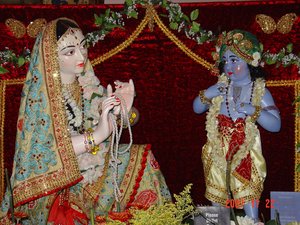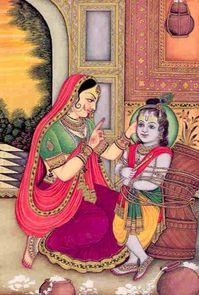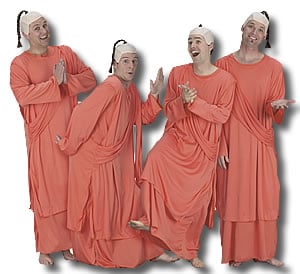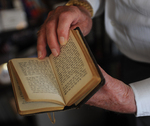Today marks the last day of the lunar month of Kartika (???????), a sacred time of year chock full of holidays on the Hindu calendar. Some of these, like Diwali, are well-known and celebrated widely. Others — days like Karva Chauth or Bhaya Duja or Bahulastami — are observed regionally or are specific to particular traditions or denominations.
The month itself, also known by the name of Damodara, is considered holy in itself and is venerated by all Hindus, but especially cherished by devotees of Lord Krishna, the Divine in its most intimate, charming, and personal manifestation.
The name Damodara — which denotes both the month and the particular aspect of Krishna that is celebrated within it — gives us a special glimpse into that intimate, charming, personal side of God. It literally means “He whose belly is tied up” (damo = tied, udara = belly), and honors the lila (pastime) of Krishna as a naughty boy being tied up by his mother, Yasoda Mayi. So beloved is this episode, that to this day devotees place a picture or murti commemorating it on their altars and offer candles and oil lamps before it every day of the month.
But how did this come to be? And what can it tell us about our own faith today?
 A brief re-telling of the story:
A brief re-telling of the story:
Once in a previous age, on
the day we now commemorate as Diwali, Mother Yasoda had her darling son
Krishna (who was only a toddler at the time) in her lap and was
lovingly nursing him. The two of them were enjoying the sweet exchange
of mother and child, when suddenly Yasoda heard the milk she had placed
on the nearby wood stove boiling over. Earlier that day, Yasoda had
resolved to put an end to the rumors that her boy Krishna was stealing
butter and yogurt from their neighbors, by making such gourmet dairy
preparations for him that Krishna would forget all about anything else.
Now the milk she had set to boil was boiling over. As much as she was
enjoying Krishna’s company, Yasoda decided that her service to Krishna
(tending to the milk on the stove) was more important even than
relishing his company; she gently placed him down and hurried to the
kitchen. Krishna, however, was not at all happy with this. His little
eyes burned red with anger and welled with tears, and he bit his lower
lip to control his crying. Desiring vengeance, he quickly made his way
to the rafters where clay pots held the butter and yogurt his mother
had painstakingly prepared, and began to break open all the clay pots.
He literally dived in, eating to his heart’s content, and even sharing
some with the chattering monkeys he liked to play with.
Meanwhile,
Yasoda returned from the kitchen to find Krishna missing. Her heart
filled with anxiety, she soon discovered him at the epicenter of a
chaotic scene — broken clay pots, butter and yogurt strewn everywhere,
monkeys happily munching away. Seeing Yasoda and knowing that he was in
trouble, little Krishna began to run away from her in fear. Yasoda
chased behind him, externally angry with the mischief he caused but
secretly wanting nothing more than to embrace him. Finally, she caught
him and — to ensure he wouldn’t run away again — decided to tie him
up to a wooden grinding mortar.
She found some rope and began to
delicately wrap it around her son’s rotund belly. It was, she
discovered, too short by the length of two fingers. Quickly, she
gathered up some more rope and added it to that; still, much to her
astonishment, it was two fingers too short. She gathered up all the
rope she could find in her home (according to some tellings, she
gathered up all the rope she could find in the whole village), but it
was always two fingers too short. Exhausted and unable to grasp how
this could be possible, she finally just gave up trying to figure it
out. At the time, little Krishna (who had been secretly enjoying
watching his mother’s efforts) relented and allowed himself to be
bound. Commentators have explained the mystery of Krishna being bound
like this: the two fingers are faith and works, the divine grace of the
Supreme and our sincere efforts to know and serve him. The rope is
Yasoda’s pure love for Krishna, a force so powerful that he has no
choice but to allow himself to be bound by it.
Materialists
hear the story and don’t know what to make of it. Atheists scoff at it,
considering it just another fairy tale from backwards superstitious
people. Even the pious might only be able to appreciate it as some sort
of divine play, or an extended metaphor perhaps.
But dive
deeper, the Bhakti saints and poets beg us, and try to hear the story
with the heart, not through the filters of the mind and senses. What
if, in addition to the symbolic and philosophical significance, the
Divine really does take the form of a small, naughty child. What if the power of love is really so great that the Supreme Controller of all can actually be subdued by a simple village woman? Now that
would really be something, wouldn’t it? A God who acts like God —
ruling, judging, officiating — is wonderful. But a God who can
transcend even his own God-hood to enact pastimes with mothers and clay
pots of butter and monkeys, a God who can cry and run and even be tied
up… now that is a God that is more wonderful still.
And so
the Damodara story is all about marveling celebrating the paradoxes.
There are many; here are a choice few to meditate on:
- The Supreme is celebrated as aja, the Unborn; here, he appears a toddler, filling his days with play and mischief.
- The Divine is the parent of all creation, and the source of all nourishment for us; here, he is being nursed by his mother.
- God
is the source of all morality, and repeatedly instructs us to uphold
virtues of honesty, patience, and equanimity; here, he becomes angry
and impatient, steals and breaks things. - The Divine is the
fountainhead of fearlessness, glorified as the “death of death itself”;
here, he runs in abject fear of his mother’s chastisement. - The Lord is the refuge and comfort of the downtrodden; here, his eyes fill with tears.
- The
Supreme is described as faster than the speed of the mind, who great
scholars and powerful yogis can only hope for a fleeting glimpse of;
here, not only does Yasoda chase after him, but she actually catches
him!
And, of course, perhaps the most striking paradox of all: Krishna promises liberation to everyone (indeed mukti,
or liberation, is often cited as the ultimate goal of the faith), and
yet is himself bound up. This, then, is an inner meaning of the
Damodara pastime: even higher than even liberation is love, more
powerful than mukti is bhakti. By the power of love, one can actually bind the Supreme.
 Kartika
Kartika
is the month where this aspect of divinity, usually buried deep in
esoterica and covered over by intellectual speculation and day-to-day
religiosity, bubbles to the surface. It is the time of year where the
wranglings of the head are put to shame by the yearnings of the heart.
Kartika boggles the mind and causes the head to spin; and this is
exactly the point. It celebrates paradoxes that can only be reconciled
through love.
For at least one month in the year, the sages
implore us, don’t just see through the eyes or hear through the ears,
but allow the heart to open to the inifinte wonders of the Supreme.

